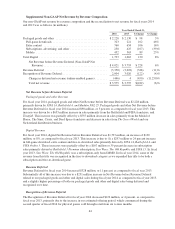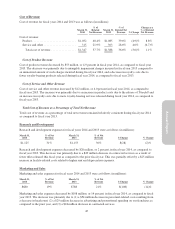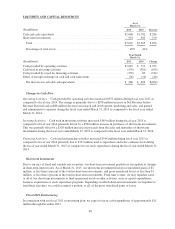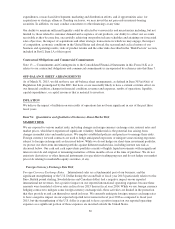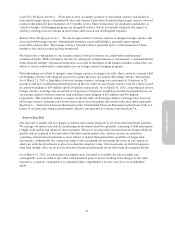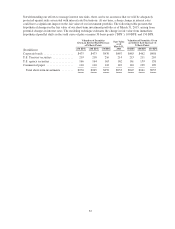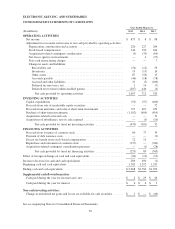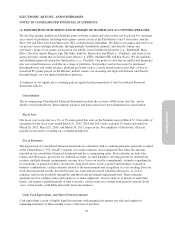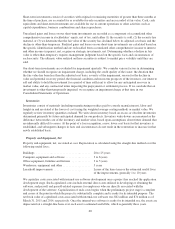Electronic Arts 2015 Annual Report Download - page 121
Download and view the complete annual report
Please find page 121 of the 2015 Electronic Arts annual report below. You can navigate through the pages in the report by either clicking on the pages listed below, or by using the keyword search tool below to find specific information within the annual report.
Annual Report
Cash Flow Hedging Activities. From time to time, we hedge a portion of our foreign currency risk related to
forecasted foreign-currency-denominated sales and expense transactions by purchasing foreign currency forward
contracts that generally have maturities of 15 months or less. These transactions are designated and qualify as
cash flow hedges. Our hedging programs are designed to reduce, but do not entirely eliminate, the impact of
currency exchange rate movements in net revenue and research and development expenses.
Balance Sheet Hedging Activities. We use foreign currency forward contracts to mitigate foreign currency risk
associated with foreign-currency-denominated monetary assets and liabilities, primarily intercompany
receivables and payables. The foreign currency forward contracts generally have a contractual term of three
months or less and are transacted near month-end.
We believe the counterparties to our foreign currency forward contracts are creditworthy multinational
commercial banks. While we believe the risk of counterparty nonperformance is not material, a sustained decline
in the financial stability of financial institutions as a result of disruption in the financial markets could affect our
ability to secure creditworthy counterparties for our foreign currency hedging programs.
Notwithstanding our efforts to mitigate some foreign currency exchange rate risks, there can be no assurance that
our hedging activities will adequately protect us against the risks associated with foreign currency fluctuations.
As of March 31, 2015, a hypothetical adverse foreign currency exchange rate movement of 10 percent or 20
percent would have resulted in potential declines in the fair value on our foreign currency forward contracts used
in cash flow hedging of $59 million and $118 million, respectively. As of March 31, 2015, a hypothetical adverse
foreign currency exchange rate movement of 10 percent or 20 percent would have resulted in potential losses on
our foreign currency forward contracts used in balance sheet hedging of $25 million and $50 million,
respectively. This sensitivity analysis assumes an adverse shift of all foreign currency exchange rates; however,
all foreign currency exchange rates do not always move in such manner and actual results may differ materially.
See Note 4 — Derivative Financial Instruments to the Consolidated Financial Statements in this Form 10-K as it
relates to our derivative financial instruments, which is incorporated by reference into this Item 7A.
Interest Rate Risk
Our exposure to market risk for changes in interest rates relates primarily to our short-term investment portfolio.
We manage our interest rate risk by maintaining an investment portfolio generally consisting of debt instruments
of high credit quality and relatively short maturities. However, because short-term investments mature relatively
quickly and are required to be reinvested at the then-current market rates, interest income on a portfolio
consisting of short-term investments is more subject to market fluctuations than a portfolio of longer term
investments. Additionally, the contractual terms of the investments do not permit the issuer to call, prepay or
otherwise settle the investments at prices less than the stated par value. Our investments are held for purposes
other than trading. Also, we do not use derivative financial instruments in our short-term investment portfolio.
As of March 31, 2015, our short-term investments were classified as available-for-sale securities and,
consequently, were recorded at fair value with unrealized gains or losses resulting from changes in fair value
reported as a separate component of accumulated other comprehensive income, net of tax, in stockholders’
equity.
51





